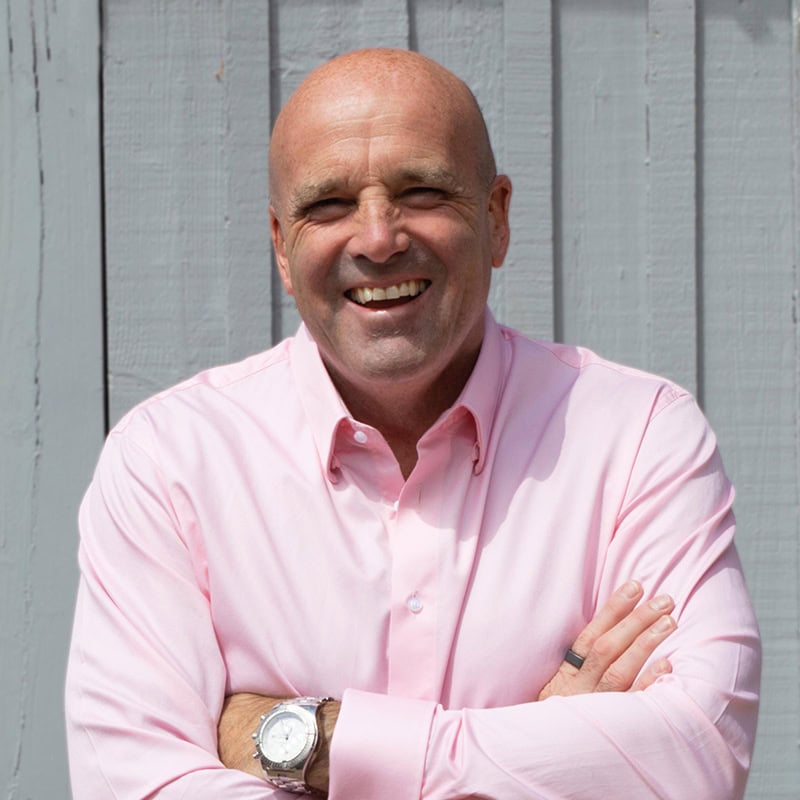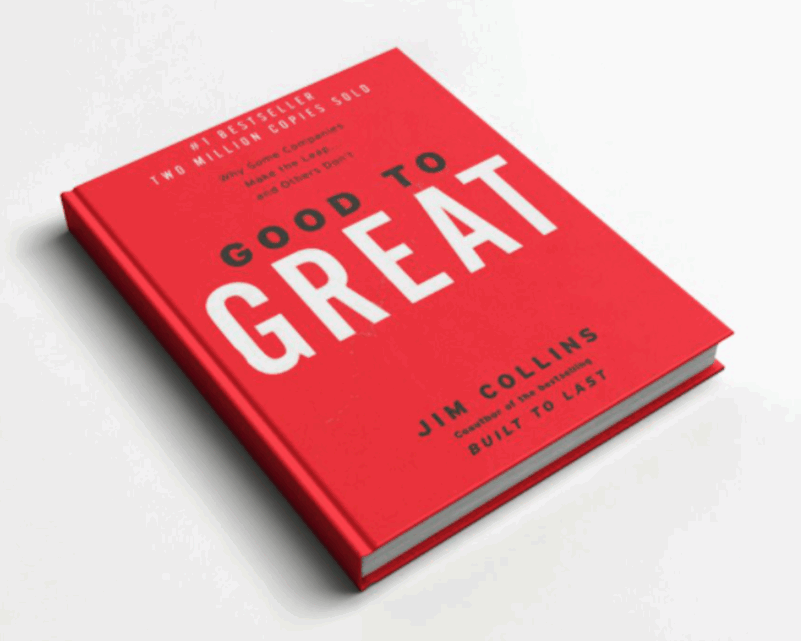The research that separates £30m scale-ups from the rest (and the critical lesson you can apply today
Back in the late ’90s, Jim Collins and his team locked themselves away for five years to crunch through the data on 1,435 companies. After much caffeine and probably a few nervous breakdowns, they found just 28 that made the leap from “meh” to “magnificent” – and stayed there for three decades.
The punchline? Almost everything the business press tells you about greatness is bollocks:
- The best leaders weren’t rock-star visionaries. They were humble, stubborn-as-hell “Level 5 leaders.”
- Tech wasn’t the silver bullet. It sped things up, but it didn’t cause the transformation.
- There was no big bang moment. Just relentless flywheel momentum, compounding year after year.
- And strategy? That came after the people. First get the right ones on the bus. Then decide where to drive it.
These aren’t just theories – they’re the operating system behind real £30m+ scale-ups. Companies that applied these principles didn’t just grow; they transformed. And the truth that most CEOs still miss is this: who you hire matters more than any vision deck or five-year plan.
Ready to dive into the lessons? Let’s roll.
The gems Collins and his research team shared proved to be actionable during my time as MD at Rackspace, ITLab and Peer1. Now they form the basis of my coaching practice.
📋 Want to see how your business measures up?
Download the free Good to Great Business Checklist and score your company on all 7 principles. Get a clear picture of where you excel—and where you need to improve. Get Your Free Checklist
✓ Instant download ✓ No email required ✓ 100% free
Summary of Good to Great: What can you learn from Jim Collins’ Book?
Good to Great isn’t your usual business fairy tale. Collins didn’t set out to write another airport-shelf pep book. He tore into the comforting myths we like to believe about what makes a company genuinely exceptional.
And the punchline is almost disappointingly sensible. True greatness has very little to do with charismatic leaders, flashy strategy decks, or whatever new tech toy happens to be in vogue. It comes from the dull, unsexy graft most people avoid. Humility. Discipline. Consistency. Getting the right people in the right seats before you start shouting about the destination. It’s hardly TED Talk material, but it actually works.
Of course, some early critics moaned that his findings only applied to lumbering corporate beasts. Fair point. So Collins went back, dug into smaller, scaling companies in Great by Choice, and effectively concluded, sorry folks, the same rules still apply. Whether you’re a giant with layers of management or a lean start-up held together with hope and caffeine, the underlying mechanics of greatness look remarkably similar.
So what are the shared traits? And more importantly, which ones matter if you’re trying to build something that lasts longer than a sugar rush?
1. Good to Great companies have Level 5 Leadership
Of the founders I coach, the most successful ones share a complete lack of arrogance. They’re humble people – understanding that they don’t know everything. And, without fail, they’re driven to do the right thing by their employees, shareholders and customers.
In Good to Great, Collins asked: what makes the CEOs of great companies different? Spoiler: not charisma, not flashy vision, not ego. The answer was a rare mix — humility, plus an unshakable will to do what’s best for the company, not themselves. He called it Level 5 Leadership.
Level 5 leaders are the anti–celebrity CEO. No strutting, no chasing headlines. Just ruthless determination wrapped in genuine humility. They take the blame, give away the credit, and quietly obsess over making the business great — not their own profile.
That combo of humility and willpower is what separates one-hit wonders from companies that endure. Greatness looks less like a Steve Jobs keynote, and more like the quiet operator who simply refuses to quit.
One founder demonstrated Level 5 leadership only this morning. Yes – his business model was proving successful, and growth was rapid. But a greater reward lay in the opportunity to change more lives for him. He saw his business as a vehicle to do this for his employees and customers.
When you build a company that scaled from zero to £30 million in five years, the numbers are great. But the real satisfaction comes from the profound changes made to the lives of those who came to work with you. Where this got them. A business can be a slingshot for so many people, propelling them to bigger, better, greater things.
2. First Who – get the right people on the bus

This is the lesson from Good to Great. Forget everything else if you like, but remember this: nothing matters more than the people you hire. Collins calls it “getting the right people on the bus.”
It’s not about filling seats. It’s about making sure every seat is held by someone who’ll drive the business forward. Before you talk strategy or vision, you need the team who’ll actually make it happen. Get the people right, and everything else follows. Get them wrong, and nothing saves you.
Getting the right people matters. When Good to Great was re-read last Christmas, it became clear this principle needed even more emphasis. In fact, it needs to be almost maniacal about finding the right people. Maybe some founders haven’t been direct enough with their teams. From experience, it’s difficult to do the work necessary to achieve an executive team of A-Players. When looking back at Rackspace and Peer 1 days, there were certainly some of the right people on the bus. But the magic target of 80 – 90% A-Players was never reached. And that’s despite the rigorous recruitment systems introduced (at Rackspace, the joke was that it was harder to get a job than get into Oxford. Great to see they still use this analogy in the US, saying it’s harder to get into Harvard).
You need tools like Patrick Lencioni’s Working Genius tool along with Gallup Strengths – the aim is to give entrepreneurs and leadership teams the vocabulary to have difficult conversations and hold each other accountable. Work on trust and productive conflict. People need to learn this stuff through experience. That’s where the value of OKRs comes in. Building a cultural and behavioural framework and then using OKRs to create performance measurements. It’s where these two things intersect when you find your A-Players.
In Good to Great, Collins points out that you need the right people on the bus before you work out where you want it to go. So it’s fundamental. I’ve worked with clients who’ve said they want to make this transition but found it too difficult. They weren’t ready to replace colleagues or move them to other roles. But if you don’t do this, you’ll have the wrong people and culture. Your B-Players will set the behavioural standards, and you’ll build your business around them. You need A-Players to set the tone.
This isn’t just another principle—it’s the keystone that makes everything else possible.
3. To go from Good to Great, companies need to confront the brutal facts
Collins describes the experience of Admiral James Stockdale – the highest-ranked American prisoner-of-war in the Vietnam War – in Good to Great, calling it ‘the Stockdale Paradox’.
Stockdale was locked up for a long time – over eight years. Many of his fellow prisoners gave up the will to live during this time. They were the optimists. The ones who said we’ll be out by Christmas or Easter or their next birthday eventually ran out of hope. In contrast, Stockdale lived day to day, accepting the brutal reality of his situation. But he never lost faith that he would make it out alive, and it would become the defining event of his life.
Collins and his research illustrate the need to confront the brutal truths head-on. This isn’t about pessimism but a call for radical candour. It’s about facing the future, armed with an unwavering resolve to face the facts, however stark they may be. Collins suggests great companies can evidence this unwavering commitment to reality. Ignorance or denial is the antithesis of progress. Progress can only begin with truth, however unpleasant.
Despite the circumstances you’re going through, if you have a clear BHAG, you can hold fast to that mission. Your company can make the leap. Trust that you will reach your destination but accept whatever life throws at you. So often, organisations are in denial about what’s happening around them. With hindsight, I can see that most of my time at Peer 1, we were in denial about the impact of the Cloud on our business, or more specifically, AWS. Perhaps we’d have been in a different place if we’d confronted this.
4. The Hedgehog Concept

Why do some companies make the leap? Collins calls it the Hedgehog Concept — the sweet spot where three circles overlap:
- What you’re passionate about
- What you can be the absolute best at
- What actually makes you money (your profit per X). “This economic engine—what Collins calls your profit per X—becomes the single metric that drives everything.
The fox — basically your classic ADHD founder — sprints after every shiny idea going. The hedgehog just does one thing brilliantly and survives.
Most businesses act like foxes: scattergun, chasing markets they’ve no business being in. The great ones? They lock onto the intersection of passion, skill, and profit — and then double down until it hurts.
It’s not about being a jack-of-all-trades. It’s ruthless focus. Depth over breadth.
All good in theory, but when founders are asked what they could be best in the world at, they’re often met with blank faces. Even worse, laughing! Often, they’re selling lots of stuff to lots of different customers. Finding one to focus on is hard. Discussion can go round and round. Similarly, when asked what they’re passionate about, a common response is, ‘Er – nothing’ (massive face-palm!) It brings the back to having the right people. If your team finds it hard to be passionate or care enough about something, they may not be the right people. This is important. They need to evangelise your mission.
When teams get the Hedgehog Concept right, it’s transformational. Take our client, Excelsior Multi Academy Trust. Their BHAG is to be world-famous for innovation in education. This transformed how they wrote job ads, which transformed the volume and quality of CVs they received and the quality of teachers they were hiring. They’re starting to impact the wider educational arena in Birmingham. It’s inspirational to witness people taking the framework offered and using them with such an impact.
🤔 Wondering where your business stands on these principles?
Get the free checklist and assess your company in 10 minutes. You’ll know exactly which areas need attention—and which are already working. Download Free Checklist
5. Good to Great companies have a culture of discipline
Jim Collins uses the expression ‘Rinsing out the cottage cheese’ to describe the importance of good company and a culture of discipline in Good to Great. It seems a strange use of words until you understand he’s referring to athlete David Scott. During a period where Scott won six Ironman triathlons, he rinsed his cottage cheese to eliminate any excess fat. Whether this helped or not, this small action showed Scott’s disciplined thought, disciplined action, focus and commitment to being the best.
It smacks of obsession with marginal gains – the 1% that will make all the difference to performance. A constant drive to be the best. Making steady, consistent progress towards a goal. This can only come from a business culture of discipline and a constant, almost restless curiosity.
Collins’ Culture of Discipline isn’t about red tape or choking people with process. It’s the opposite. It’s about building a place where disciplined people think clearly and act consistently — without needing a manager breathing down their neck.
The magic happens when you’ve got self-motivated people who actually give a damn, combined with a clear framework for decision-making. That mix gives you entrepreneurial energy and relentless consistency.
Most companies either veer into chaos (lots of “creativity,” no results) or slide into bureaucracy (rules everywhere, soul sucked dry). The great ones strike the balance: freedom within a framework, discipline without the dead weight.
One powerful way to maintain this discipline is through a strategic council—a regular forum where your leadership team confronts the brutal facts and holds each other accountable.
It makes me twitch when I discuss business books with a prospective client, and they tell me they don’t read. I don’t know where to go next. How do you plan to go from good to great if you can’t find time to discover how others have already done it? This demonstrates a lack of curiosity, determination and discipline. There is always time to read and improve your knowledge. Where would I be without Jim Collins, Verne Harnish, and Patrick Lencioni? Who would have given me the frameworks on which I’ve built success for my teams? Returning to Level 5 leadership, there’s a link between humility and reading. Successful CEOs will have the discipline to read at least 12 books a year. It’s why their companies make the leap and why we run our book club here at Monkhouse & Company.
6. Technology accelerators move companies from Good to Great
According to Collins, good to great companies think differently about technology. Instead, they avoid fads and focus solely on technology that can accelerate momentum in the Hedgehog Concept.
In an older piece of research, McKinsey found that 17 – 20% of companies that do IT projects well go on to invest in more IT. But the opposite is also true – if there’s a track record of failure, it puts companies off further IT investment leading to divergence over time. Digital transformation is difficult, no question. But it’s not impossible. If your business fails at IT, you must change your people, suppliers, or tools. But don’t stop investing. You can bet one or more of your competitors will use technology well.
At Peer1, we nailed tech as an accelerator. We automated server provisioning and customer onboarding, which supercharged our hosting machine — our Hedgehog in action. But here’s the ugly bit: we flat-out ignored cloud computing because it didn’t fit our existing kit. Classic case of selective blindness. And it cost us, big time.
The lesson? Tech doesn’t create greatness — it just speeds up whatever direction you’re already pointing. Pick the right tech and it’s rocket fuel. Pick the wrong blind spot and you’ll get left behind.
7. Good to Great companies build a flywheel of momentum

Transformation isn’t a lightning bolt. There’s no killer app, miracle hire, or one-off masterstroke. Collins nails it with the Flywheel: greatness comes from shoving a giant, heavy wheel, turn after painful turn, until momentum finally kicks in and it spins on its own.
Success isn’t one heroic push. It’s thousands of small ones, all in the same bloody direction. Every hire, every choice, every action adds weight. Stick at it long enough, and the compounding force takes over.
The opposite is the Doom Loop: leaders binning strategies every quarter, chasing shiny fads, expecting instant miracles. All that stop–start nonsense kills momentum before it even starts.
Great companies grind through the flywheel, however boring it feels at first. Mediocre ones live in the doom loop — hooked on the sugar rush of “new” but never building anything that lasts.
I often discuss this idea with new clients and suggest we look for flywheels in their business. This sums up what I do for a few people for a living – uncovering the flywheel of their business model. Yes – they have a plan containing their numeric hopes and dreams. But to get there, they need a model that begins to spin for itself. Vision, core customer, culture, innovation – once properly calibrated, everything interlinks to build the momentum you need for growth.
The one lesson that changes everything
Of all Collins’ big seven, one towers over the rest: get the right people on the bus. Miss this, and the whole thing collapses like a dodgy soufflé.
- Your hedgehog concept? Becomes academic fluff.
- The flywheel? Doesn’t spin.
- Culture of discipline? More like culture of chaos.
I’ve watched “genius” strategies die a slow, painful death because the wrong people were steering the ship. And I’ve seen half-arsed strategies succeed spectacularly — purely because the team were killers.
That’s why about 80% of my coaching is basically talent triage. Forget polishing visions. Forget drawing pretty flywheels. Get the bloody people right first.
Four ways I can help (ranked by impact, but also by how much effort you’ll have to put in):
- Book a call — the deep end. We’ll tear into what’s holding your business back, rebuild it properly, and leave you with a plan you can actually execute. Bring coffee.
- Grab the book F**K PLAN B — it’s my brain in print. Packed with frameworks, blunt truths, and enough stories to make you feel slightly better about your own mess.
- Subscribe to the newsletter — easiest lift. Think of it as free consulting, minus the awkward meetings: short, sharp, and occasionally sweary insights straight to your inbox.
- Download the Good to Great Business Checklist Put these lessons into action and get a clear picture of where you stand—and what to fix first. Used by 1,000+ founder CEOs to scale their businesses.
Your move. Keep spinning your wheels, or finally get the right people on your bus.

